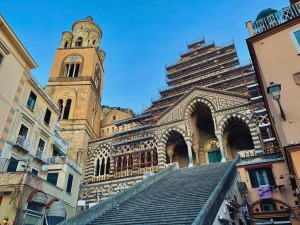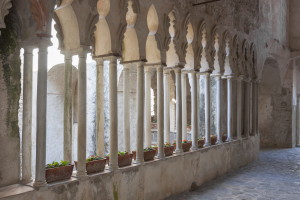One of the most beautiful regions in all of Italy is situated at the Gulf of Salerno. The Amalfi Coast in Campania is home to breathtaking nature, magical views and numerous small villages, all connected by just one single road. The main town Amalfi with its steep hills, countless cafés and amazing beaches is a must-visit during a tour of the UNESCO World Heritage Site Amalfi Coast. But that’s not all by a long shot: Amalfi is a genuine city of arts with pretty exciting architecture, a storied history and many a surprise. Join us on our coastal tour!
The power of the former maritime republic
The exact origins of Amalfi are unknown. The city was likely founded by soldiers of Constantine the Great from the Adriatic coastal village Melphe around 320 AD. “A Melphe” (“from Melphe”) might have become Amalfi, but there’s no definite documentation about that. What we do know, however, is that the residents quickly turned to maritime trade as there was hardly any fertile soil in the region. Amalfi was mostly autonomous, gained independence, and became one of the first ever maritime republics. It had way over 50,000 inhabitants during the 10th century and was the main trade hub between (Southern) Europe and the Orient.
Norman threats and invasions considerably weakened Amalfi while it was at the peak of its power; eventually, Norman ruler Robert Guiskard conquered the maritime republic in 1073. It gradually lost its significance after that and was lastingly debilitated by two Pisan attacks in 1135 and 1137. A devastating tsunami, the result of an earthquake, destroyed most of the city in 1343. Amalfi never fully managed to recover. However, the Tabula Amalphitana, Italy’s first codification of maritime law, survived the maritime republic by centuries. Amalfi finally experienced a proper upswing in the middle of the 20th century thanks to the blossoming tourism and has been a popular summer destination since.
The Cathedral complex

©Bigstock.com/NejroN Photo
Amalfi’s cityscape was established on and around the steep hill unearthing many an unexpected treasure hardly noticeable during a mere coastal tour along the Strada Statale. The Cathedral of the Diocese of Amalfi-Cava de’ Tirreni is among the most splendid buildings of the entire city of arts. The first church was established as early as the 9th century and now houses the diocesan museum. Today’s Cattedrale di Sant’Andrea dates back to the 10th century and was converted multiple times. It first received an Arab-Norman look, then got a baroque overhaul. The colourful mosaic façade was added during the 18th century.
The cathedral’s actually a fairly large complex of buildings consisting of a crypt with the remains of Andrew the Apostle (Amalfi’s patron saint), the Basilica of the Crucifix with the diocesan museum, the cloister of Paradise, and the cathedral itself. You will certainly notice the hefty triumphal arch supported by two Egyptian granite pillars inside the church. Don’t miss out on visiting the other buildings, particularly the cloister Chiostro del Paradiso with its idyllic atmosphere.
Sights in Amalfi
But that’s far from everything there is to see and experience in the city of arts Amalfi. Strolling through the place will get you close to the region’s thrilling history. Don’t miss out on the following sights on your day in Amalfi:
- Santa Maria a Piazza: This small Renaissance church, hardly bigger than a chapel, was built in the 15th century where numerous stores and craftspeople used to be. The compact beauty is full of stunning paintings and reliefs.
- Museo della Carta: Amalfi’s citizens learned the art of papermaking many centuries ago turning the city into one of Europe’s first paper centres. The old paper mill was turned into a museum in 1969 exhibiting machinery and equipment from days long gone.
- Sant’Antonio: It is said that Saint Francis of Assisi founded this church and its convent during a pilgrimage to the remains of Andrew the Apostle. The convent is closed for visitors expect for one afternoon per year. However, the colourful, very impressive interior of the otherwise seemingly plain church fascinates.
- Gli Arsenali della Repubblica: Trade ships and warships had to be built, maintained and stored during the days of the maritime republic. Amalfi owned the largest galleys in the Mediterranean during the Early Middle Ages. What survived of the arsenal are mostly architecture and sculpture remains, partially due to erosion. Various ships and the boats of a historical regatta are exhibited here.
The Amalfi Coast

©Bigstock.com/mailos
If you’re in Amalfi, you pretty much have to tour the entire Amalfi Coast, don’t you? Look forward to gorgeous views of the Gulf of Salerno and the steeply sloping coast along the magnificent coastal road Strada Statale 163 Amalfitana on its 50 km from Meta di Sorrento to Vietri sul Mare. This drive is certainly not for the faint of heart due to overhanging rocks and the narrowness of the road, but the scenery is just divine. And that’s far from all you get to experience up and down the Amalfi Coast:
- Wine and limoncello: La Dolce Vita is everywhere at the Gulf of Salerno. The Amalfi Coast is a popular winegrowing region with excellent red wines and white wines carrying the controlled destination of origin label DOC since 1995. How about some limoncello instead? Excellent lemons with juicy meat and little pips grow in the coastal region. Taste the result in the lovely cafés and inns along the way.
- Long-distance hiking: You’d rather travel on foot and love challenges? Several hiking trails run along the coast. Six taxing full-day stages from Salerno to Sorrent or Schiazzano via Amalfi await you on the CAI-300 and on parallel paths. That’s up to 74 km for the longest trail version with 4,380 altitude metres uphill and 4,718 altitude metres downhill. Are you ready for the challenge?
- Stunning places: Whatever you have planned for your coastal tour, there are many great places to explore beyond the city of arts Amalfi. Take Ravello, for example, where many rich citizens lived during the Middle Ages. Numerous well-maintained villas including the awe-inspiring Villa Rufolo make you feel like you’re in a different era altogether. There’s a Benedictine monastery founded in the year 973 on a rock high above Maiori. Furore even has its own fjord and is regarded as one of Italy’s most beautiful villages for a very good reason. And then there’s Positano, a colourful place with countless churches, Roman ruins and an unusually holey rock.
Visiting the city of arts Amalfi is a must when planning a tour of the Amalfi Coast. The main town hasn’t lost any of its maritime republic allure even though things are a bit smaller and quieter these days. The friendly town with its charming sights and the endless views is perfect to kick back and dream the day away.